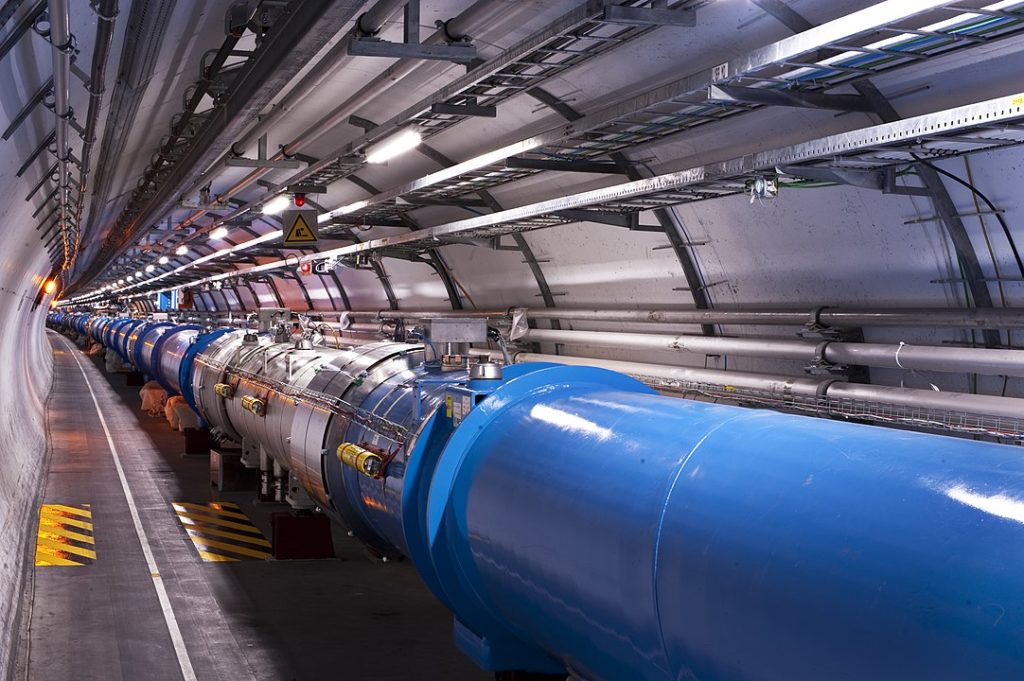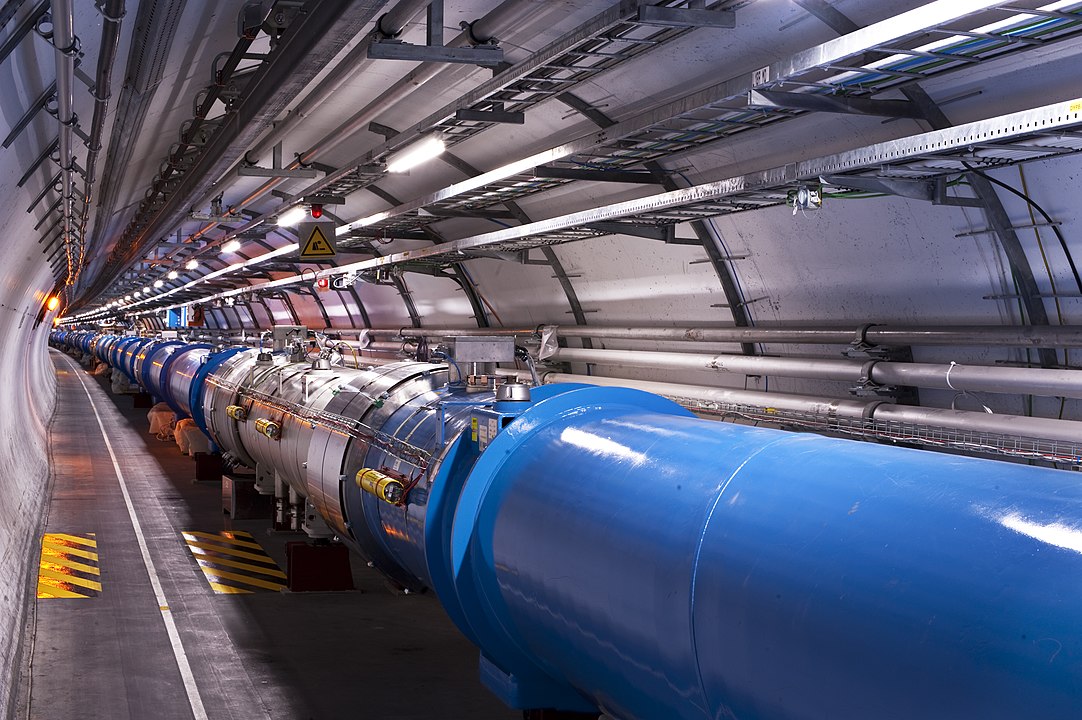
I learned this today. The Large Hadron Collider accelerates particles to close to the speed of light by using electric fields and radio waves.
The Large Hadron Collider (LHC) was built between 1998 and 2008 for CERN, the European Organization for Nuclear Research. I know you are thinking that should be EONR, but CERN comes from the French Conseil européen pour la recherche nucléaire, and CERN is much easier to say than EONR. It cost close to $5 billion and the money was raised by the member countries.
It is built beneath the ground, underneath the borders of France and Switzerland at Geneva. It is in a tunnel with a circumference of 27km.
It is called the Large Hadron Collider because it is very big and it collides hadron particles (protons and neutrons) together.
The goal of the scientists running the LHC is to have particles crash into each other at speeds close to light speed. This is obviously not easy to do. First they have to get the particles that they want to collide, then they have to accelerate them to incredible speeds, and finally they have to make them crash into each other.
The particles are taken from hydrogen atoms because it is the simplest atom, with just one proton and one electron. Hydrogen gas is passed through an electrical field, which strips away the electron, just leaving the proton. This is probably the easiest part.
To accelerate the particles, the LHC uses electric fields. The protons taken from the hydrogen atom are positively charged. A positive electric charge attracts positive protons and a negative charge repels them. The controllers of the LHC pulse the electric fields from positive to negative at certain frequencies to pull the protons through the LHC. They also do this to make the protons group up in bunches instead of travelling in a constant stream. The protons don’t start and end in the LHC, they are fed into it from a connected group of other tunnels and rings, each one increasing the speed of the protons.
The electric fields give the protons speed, but most of their energy comes from radio waves. At different points along the LHC are radiofrequency cavities. These are areas that are programmed to resonate at a specific frequency creating radio waves. When the charged protons enter the radiofrequency cavity, they interact with the radio waves and pick up energy from them. This energy makes the protons go faster. This is continued until they are travelling at close to the speed of light. To make sure they don’t hit any other particles on their journey, the LHC is a vacuum.
The protons can’t be left to travel on their own, though, because they would just go in a straight line. They have to be guided and this is done with extremely powerful magnets. 10,000 magnets of differing strengths. Some of the magnets are used to guide the protons and some of them are used to concentrate the protons in a closer bunch. These magnets are superconducting electromagnets. They conduct electricity without resistance or loss of energy, so long as they are kept at ‑271.3°C. They are cooled using liquid helium. Many of these magnets produce a magnetic field that steers the protons along the LHC. The trouble is, the more energy the proton has, the more energy is needed to make a strong enough magnetic field. During an experiment, the LHC uses the same power as 30% of the nearby city of Geneva.
Once the protons are at near the speed of light and the electromagnets are steering them and concentrating them into a close beam, they have to be crashed together. The radiofrequency cavities that the beam of protons passed through broke them up into bunches. There are about 110 billion protons in each bunch and there are 2,808 bunches in a beam. Two beams are sent in different directions around the LHC, clockwise and anticlockwise. When they are at speed, they go round the LHC 11,245 times every second. The magnets direct the two beams to a collision point and they collide. Well, some of them collide. 110 billion protons intersect 110 billion protons, but they are so small that there is a big chance they will miss each other. The ones that don’t collide carry on and are absorbed by a graphite barrier.
When the protons collide at such high speed, they break apart and the particle detectors can detect the subatomic particles that they are made of, such as the quarks and gluons. What those are is something for me to learn another day.
So, the Large Hadron Collider works by removing the electron from a hydrogen atom and then speeding it up using electric fields and also breaking it up into bunches. The proton beam passes through a radiofrequency cavity where the radio waves give more energy to the beam. Magnets steer the beam and compress it into a narrow beam before the protons beam collides with another beam. Detectors work out what is left after the protons hit each other. And this is what I learned today.
By Maximilien Brice (CERN) – CERN Document Server, CC BY-SA 3.0, https://commons.wikimedia.org/w/index.php?curid=29068933
Sources
https://home.cern/science/accelerators/large-hadron-collider
https://home.cern/resources/faqs/facts-and-figures-about-lhc
https://en.wikipedia.org/wiki/Large_Hadron_Collider
https://science.howstuffworks.com/science-vs-myth/everyday-myths/large-hadron-collider.htm
https://theconversation.com/explainer-how-does-an-experiment-at-the-large-hadron-collider-work-42846
https://home.cern/science/accelerators/how-accelerator-works


[…] means they conduct electricity without any electrical resistance. The electric magnets used in the Large Hadron Collider are superconductors. They are cooled to close to absolute zero using liquid helium and the same […]